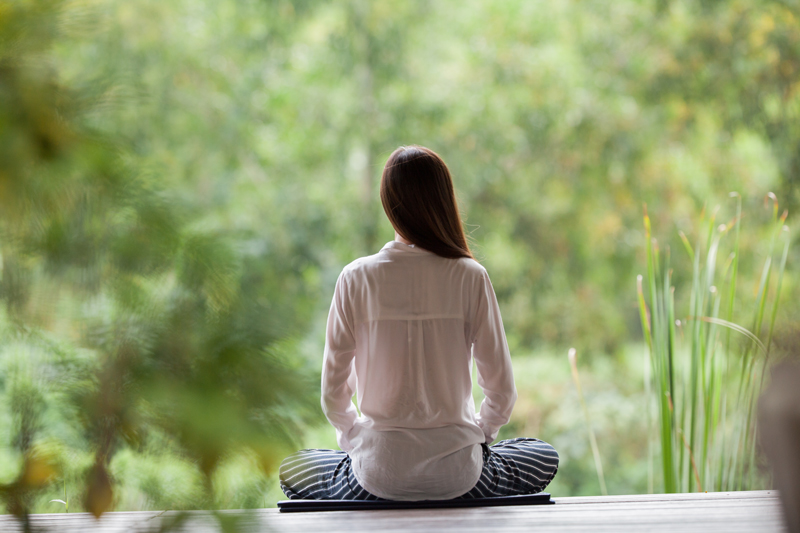
Meditation is a hot subject these days. You hear about it everywhere.
And like any subject that is popular in Facebook feeds and new shows, there can be a number of myths and misunderstandings about it.
7 Meditation Myths
In this first part of a 3-part series on “Common Meditation Myths”, we’ll look at what is meditation. Oddly, defining meditation can be one of the trickiest things about learning to meditate.
Just what exactly is it? Is it being mindful? Focused? Sitting in open awareness?
We’ll look at many of the ideas people have about meditation and compare that to what it really is.
Myth #1: Meditation is all about focus and concentration
There are many meditation traditions and techniques. Even though they can be very different, a common theme is that meditation trains your mind.
One way or another, they promise to change your state of consciousness, to help you see clearly, find peace, or gain self-knowledge.
To develop these skills, some meditative techniques use focus and concentration. You might focus on your breath. You might bring your attention back to a single point every time it wanders.
But many techniques do not focus. Some broaden your awareness to include all of your surroundings. You are open. Expansive.
And still other techniques use chanting, visualization, contemplation, or mantras.
Depending on what type of meditation you use, focus and concentration are just two of the practices you may develop.
Myth #2: Meditation is mindfulness
Meditation and mindfulness are two common terms, both of which have broad, vague meaning. They can be confusing because they refer to many different things and are often used interchangeably.
Generally, meditation is a broad category of practices to self-regulate and manage the mind.
Mindfulness is one of the practices. It refers to being in the present, fully aware of whatever is occurring. If you are mindful of your breathing, you are fully aware and present with the experience of breathing.
You can be mindful of any sensation or experience–from the sensations in your body to the many experiences in everyday life.
But in popular culture, meditation and mindfulness often mean the same thing.
Myth #3: Meditating means you empty your mind
There’s a common myth that to meditate, you must stop your thoughts. If you’ve ever tried to do this, you probably realized that not thinking is a very difficult task.
The root of this myth is from one common outcome of meditating. Often, your mind becomes calmer. The chatter is softer and less disturbing.
The image of a meditator sitting with an empty mind is reinforced with the many meditating saint images available. The pictures make it hard to imagine that the saints were sitting and thinking about their grocery list.
This myth gets the end confused with the beginning. While your thoughts may be less intrusive with a meditation practice, you don’t block or fight your thoughts to get to that end.
Forcing your thoughts to go away only makes them more rebellious. You work with your thoughts–not against them.
Myth #4: Meditation can teach you esoteric skills like levitating
There are some meditation traditions which believe that highly skilled masters can achieve some very unusual, quite extraordinary skills (including levitating).
However, most meditation traditions don’t focus on these practices. Even if they do, they teach that these skills are the result of meditation–not the goal.
Myth #5: Meditation is spiritual
For some people, meditation is a spiritual practice. Meditation makes them feel closer to a Higher Power or helps them find a deeper Truth.
But for others, meditation is part of their health and wellness regime.
Either way. You get to pick. Meditation is not one or the other.
Myth #6: Meditation is a wellness practice
Many people meditate to reduce stress and increase their overall contentment. They understand (and more and more research is confirming) that meditation provides many health benefits.
But for others, meditating for health alone feels flat.
Meditation includes a broad range of practices that can be practical or spiritual.
Myth #7: Meditation is… (fill in a particular technique)
There are many techniques which fall under the umbrella of meditation.
From single-pointed focus to sitting in open awareness, from contemplating a koan (a paradoxical question) to visualizing complex images, from sitting practices to walking, and from cultivating compassion to contemplating the nature of reality—all of these very different practices could be called meditation.
Meditative practices come from many different traditions, different times in history, and from different parts of the world. Some are taught in a clinical setting and others in a religious space.
Typically the techniques develop the mind or induce different states of consciousness but there is a wide range of why or how they do it.
And despite all these differences, these practices are all mashed under the idea of “meditation”. It’s no wonder that defining meditation can be confusing. Meditation can be many things.
Next month, we’ll look at common meditation myths about how you meditate–myths that can keep you from getting started or that make your practice more difficult.
Julia Rymut
Looking for the truth about mediation (and other philosophical questions)? So does Julia. Julia Rymut plays with the mind-body connection as she teaches yoga and meditation. Join her mailing list at TaraTrue.com



I find that trying to watch the breath come in and out is very difficult. I seem to try to control my breathing.
what is the best way to watch the breath?
Hi Catherine,
What a great observation! Isn’t it interesting how hard it is to be aware of something without changing it?
Your experience is very common. I have a couple of ideas for you.
First of all, there are several different techniques for watching the breath.
–You can count the breaths. If your mind wanders (and it will), you just begin again at #1.
–You can notice the sensations of breathing. For example, you may notice the movement of your chest against your clothes, your breath in your nostrils, or the sound of your breath.
–You can watch some part of the breath, for example the inhale or the exhale. One of my favorites is to watch the pause between the exhale and the inhale.
My first suggestion is that you can experiment with switching to a different technique. Some techniques work better for one person than the other. Experiment.
My next suggestion is to take breaks from watching the breath. Watch the breath for a minute, then sit in open awareness for a minute. Go back and forth–from focusing on the breath to sitting in openness. Sometimes focusing creates a little tension in the body and taking breaks can make this easier to manage.
And my last suggestion is that you make being aware of how you control your breath part of your practice (essentially, you have already done this). When you notice that you have changed your breath, make note of it in a lighthearted, non-judgmental way. “Oh look, I just changed my breath.” Realize that trying to control the breath is perfectly natural. Notice it. Let it go.
I hope one of these ideas help. Let me know if you have any questions.
Is trancendtal meditation better then just learning to meditate on your own?
Hi Shirley,
Thank you for asking. First a little background for readers who may not have heard about transcendental meditation.
Transcendental meditation (TM) is a type of meditation taught by the Transcendental Meditation organization. It was brought to the West in 1959 by Maharishi Mahesh Yogi and involves repeating a mantra–a little like chanting a phrase–over and over. TM was very popular in the 60’s and 70’s and was one of the first meditation techniques that become recognized in popular culture, especially when the Beatles began practicing it.
In general, I think it’s easier to learn to meditate when you have a supportive learning environment. Imagine a musician teaching herself to play guitar. It’s not that she can’t learn to play on her own (some people have done it). But it’s a whole lot easier with a good teacher and other students to talk to.
So I recommend that you find a class, spiritual community, or program to help you get started.
TM might be the right choice but it’s personal preference. You’ll want something that feels “right”–just the right mix of the techniques that work for you, fellow students you enjoy, and teachers who are skilled at teaching meditation.
Sometimes it takes a little trial and error but you’ll get there!
Good luck. Keep us posted on what you discover.
Hi Shirley, just wanted to quickly add to this that we have a great podcast interview on TM with About Meditation cofounder Tom Bershad. You can listen to that here: https://aboutmeditation.com/podcast/how-to-practice-transcendental-meditation/
Hello,
I must agree w/you on it is best to find the right guided learning environments. The encouragement & fellowship in such is invaluable.
Unfortunately at this time I’m unable to find that environment. I’ve had it several times in the past, but that is not the case now.
Anyway, I wanted to say that I like what I’m reading of you. I look forward to learning more.
Be Blessed
LB
Hi LB,
I’m sorry to hear that you can’t find a meditation community. Keep looking. As meditation becomes more known, there are more and more options available. I hope that you find something soon. In the meantime, keep visiting this site. There are lots of good resources here.
Check in from time to time and let us know how it’s going for you.
Hi, Since last 6 months i am doing experiments with breathing and to be watchful to thoughts. As much as i put efforts it got more and more difficult. Once i did it with out efforts i feel deeper experience. But i do not know, doing something with efforts is meditation or be in some state with out effort is meditation.
Hi Pavitra,
Congratulations on practicing for 6 months. That shows a great dedication to meditation.
And thank you for your question–it’s a good one. How do we know when we are meditating? What is the right way to do it?
Since you are already experimenting with watching your breath and thoughts, I suggest you keep doing exactly what you are doing. And since your experience got deeper when you worked with less effort, keep doing that.
From your description, it sounds like you are going in a very good direction. Meditation is the process of being present. You are being present with your breath, your thoughts, and even your experience of “effort”. By bringing all this presence to your experience, you are meditating.
Great blog! I love that you show people that it can be so many things!
Very true, Gavin. Meditation can take many different forms.